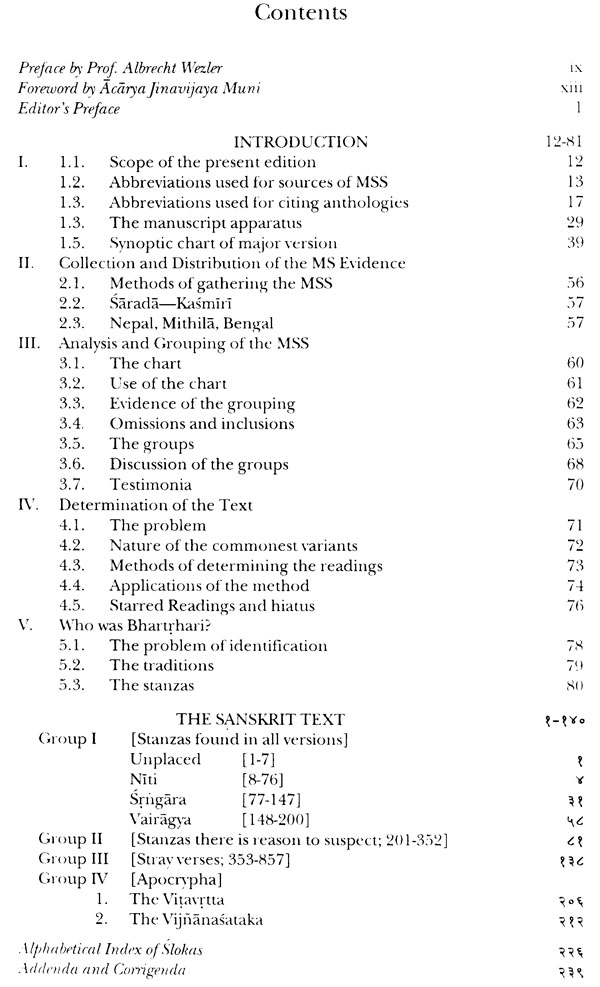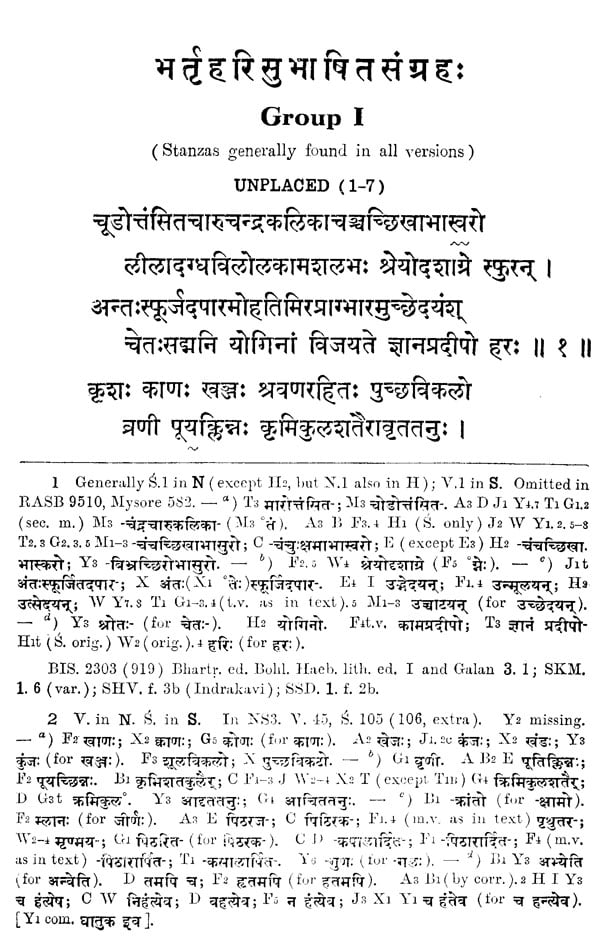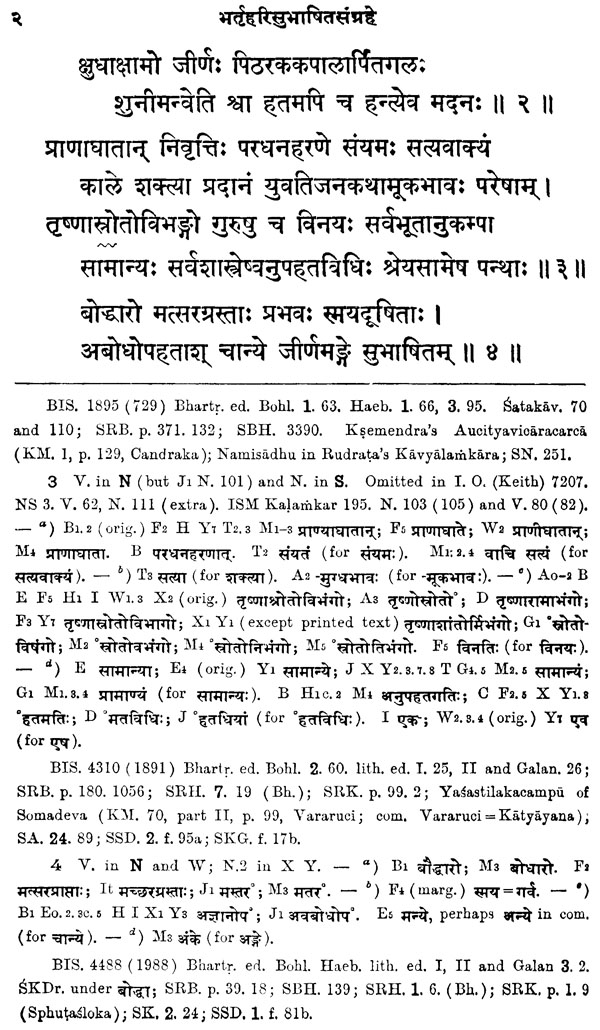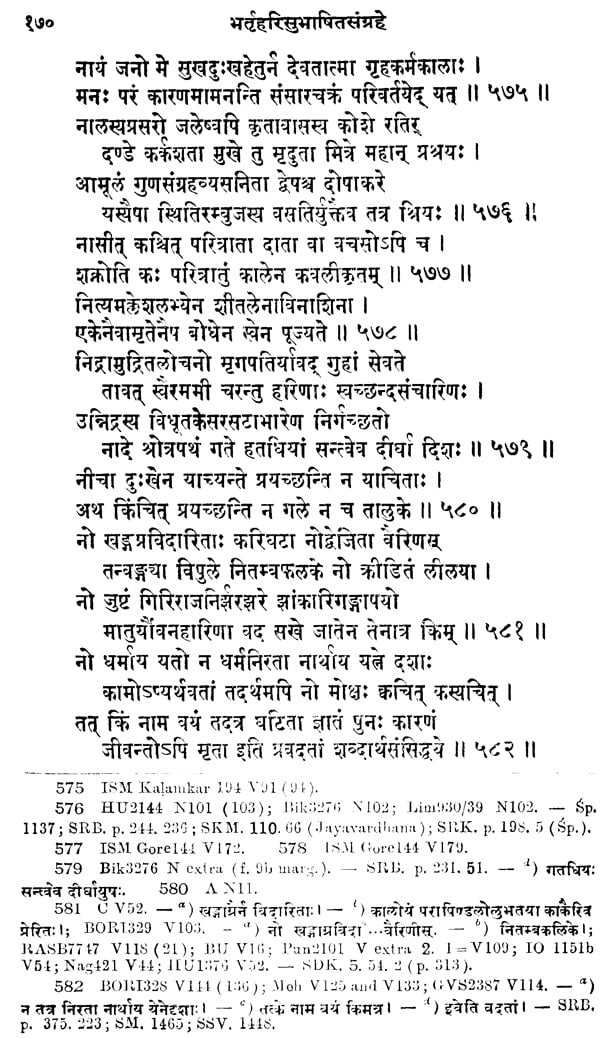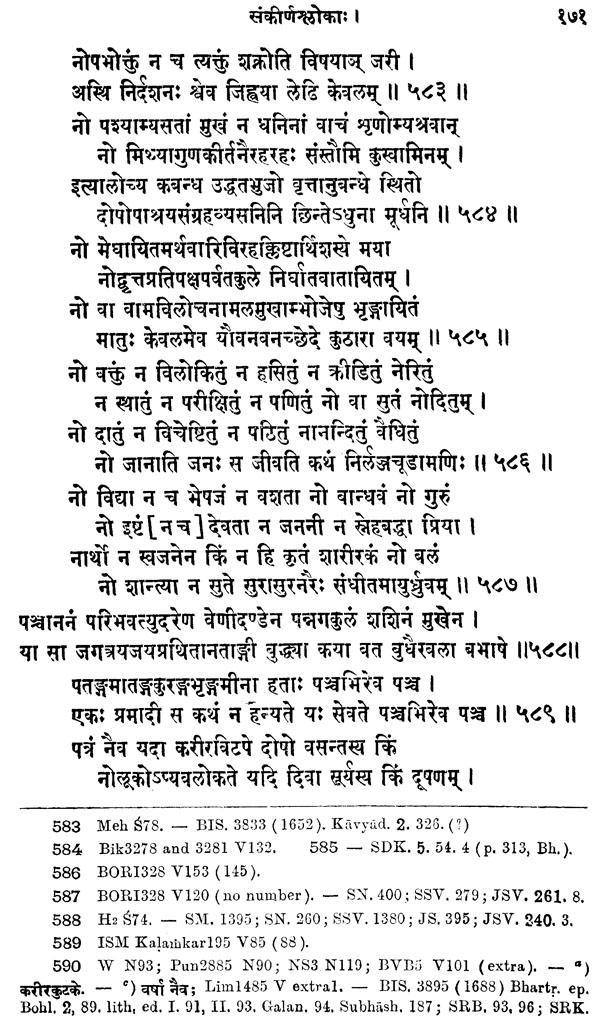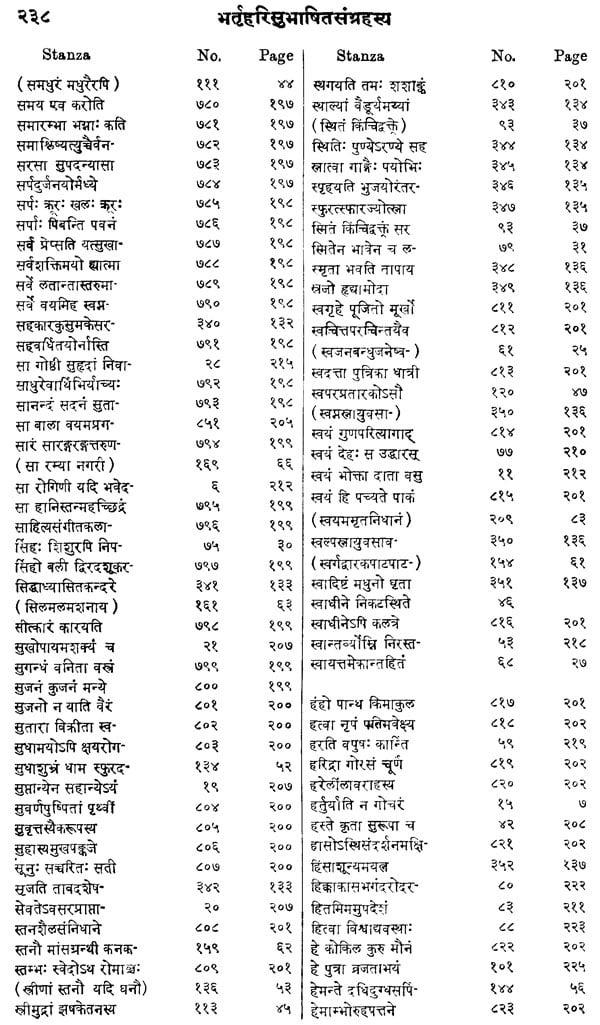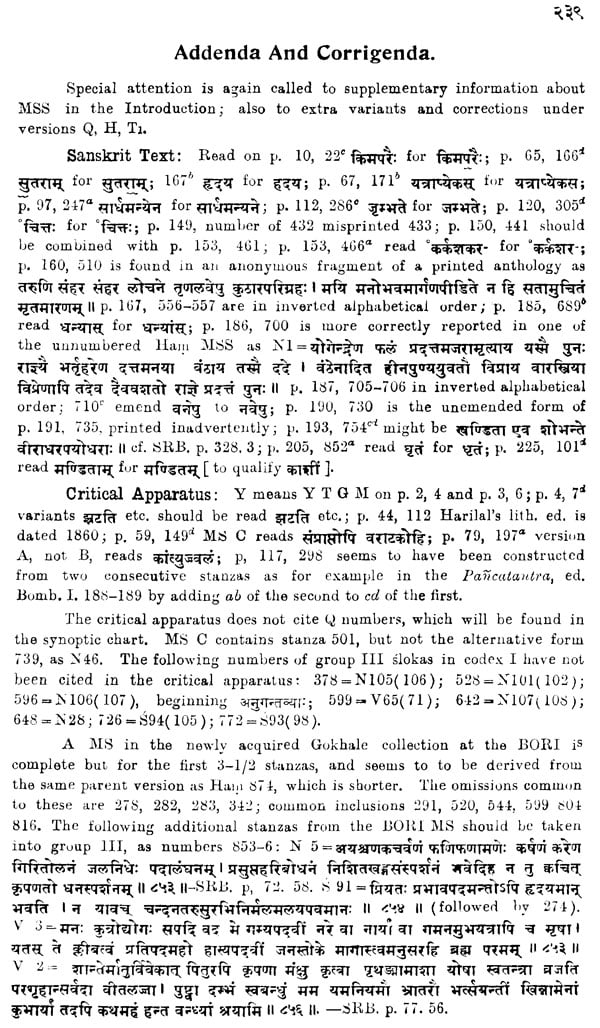
भर्तृहरि विरचित शतकत्रयादि -सुभाषितसंग्रह - The Epigrams Attributed to Bhartrhari
Book Specification
| Item Code: | MZS676 |
| Author: | D.D. Kosambi |
| Publisher: | MUNSHIRAM MANOHARLAL PUBLISHERS PVT LTD |
| Language: | Sanskrit and English |
| Edition: | 1948 |
| ISBN: | 8121509750 |
| Pages: | 254 |
| Cover: | HARDCOVER |
| Other Details | 10.00 X 6.50 inch |
| Weight | 710 gm |
Book Description
A must for all sahrdayas!
D.D. Kosambi himself thought of this his work as a "definitive critical edition" (Kosambi 1946: 64), and the justification for making such a claim is quite clearly borne out by the fact that no serious scholar has thought of basing his/her research on any other edition of the 'Triad' since the publication of Kosambi's edition. And, to be sure, this "first critical edition", as it is called by the editor himself unassumingly (Kosambi 1948: Editor's Preface 8), will remain definitive for many, many more decades to come, and not only because nowadays scholars do not as a rule have the stamina and extraordinary per- severance which enabled Kosambi to examine 377 manuscripts (cf. Kosambi 1948:'Editor's Preface 2, also as regards the "exaggerated notion of precision" this number suggests)-out of a total of approximately 3,000 surviving manuscripts, styled a ''very conservative estimate" by him (Kosambi 1948: Editor's Preface 10)-not to mention the difficulties he had to overcome in order to get the manuscripts or copies of them. And how great these difficulties were can easily be inferred from his remark (Kosambi 1948: Editor's Preface 10) "(I) t is a general rule (Kosambi's law!) that the actual use-value of a manuscript is inversely proportional to the fuss made in lending it." Even if, to be fair, it is admitted that after Independence the situation has much improved for anyone who wants to obtain copies of manuscripts from India, it should not be forgotten that, although the work ascribed to Bhartrhari is "small enough to be handled completely by one man, unaided"! (Kosambi: Editor's Preface 1), anyone who might think of repeating Kosambi's great feat, completed within less than five (!) years, would have to produce like him "more than 400 large collation sheets ... for the determination of the variants, ... thousands of index cards and slips, and the rest" (cf. Kosambi 1948: Foreword by Jinavijaya Muni) , and it still remains to be seen whether all in all computers really make the task of scholars preparing critical editions any easier. Besides, there is, it seems, no need for a new critical edition of the Satakatraya; I don't know of 'In fact, as he himself states, Kosambi did not entirely lack all assistance (Kosambi 1948: Editor's anybody who is calling for one or who has the arguments necessary to support such a demand.
Kosambi's edition will hence prove definitive long into the future, and this is, of course, mainly due to its quality and organization: Kosambi was quite evidently an extremely intelligent, prudent and thoughtful man, well familiar with the methods of higher and lower textual criticism (which he learnt from his father, and also from V.S. Sukhthankar, who was the one who suggested undertaking the critical edition), of a remarkable knowledge of Sanskrit (although he learned this wonderful language only comparatively late in life), and a vast erudition as regards things Indian; and above all he had a critical mind. His "Preface" alone is ample proof of all this. In order to see this for oneself it is not necessary to study his other works, a complete list of which we owe to his colleague and friend V.V. Gokhale (see Sharma 1984: 4ff.)-and which, by the way, includes the edition of Vidyakara's Subhasitaratnakosa. The structure of Kosambi's edition of the Epigrams Attributed to Bhartrhari is such that it is possible for readers not only to understand and critically examine his own always explicit decisions on questions of higher and lower textual criticism, but also to take exception with him, if need be-a possibility deliberately allowed by him (Kosambi 1948: Editor's Preface 9): 'The reader ... can prepare his own edition from the material placed before him", even though, as again admitted by Kosambi himself with winning frankness (Kosambi 1948: Editor's Preface 9), he was not able, for lack of space, "to set forth the ideal critical apparatus-one which would allow every MS. utilized to be reconstructed with the minimum effort." But any reader is warned that before actually trying to prepare "his own edition" he should thoroughly study all that is said and explained-as lucidly a very-by Kosambi in me "Introduction", If you Mint to go b yond him, you have fir t to know hi view a intimately a possible And it would certainly not be legitimate to brut his opinion a idea for his having been a Marxist: lie made no bon S About being a follower of Marl(, Engel~ and L nylon, and indeed dedicate the edition to the e men, "from who e writing~ I fir t I armed that society can and mu t b changed before we attain the tag at which human history will b gin" (Kosambi 194 : Editor' Preface 11). But if Kosambi never concealed his philosophical and political conviction, he was far from blindly accepting everything the "teja vino maMmill1alla~ "had to y. and naively applying their theories to Indian history. Even 0ne'will wonder now and again, and so too as regard hi view about Bhartrhart, if he let him elf be impressed a bit too much by Mari t' riel of faith'.
I. I. It is here attempted to collect in a single critical edition stanzas ascribed to Bhartrhari, the poet generally credited with have written three Onetime of Sanskrit epigrams: the A study of sealcoat? MSS shows division into two major recessions, northern N and the southern S, which may be subdivided into I archetypes each, and still further into versions; this convenient divas should not be taken to imply absence of mutual influence, Moore« even the accessible N-S-V MSS contain a total of over twice the: traditional stanzas while the common portion of all supposed 'sata7catrc MSS falls well below the 300. Therefore, the stanzas have been diva here into broad groups, arranged in their likeliest order of authentic Group I contains the 200 slokas generally found in 0,11 sources, and further subdivided into into four portions: the first seven being unplat not definitely belonging to some fixed sataka ; the other three sect are in order what survives of the N, S, and V. The actual position any stanza in any major version will be found in the synoptic 1.5; my group I N-S-V follow the order of version A as far as possi groups II and III being in alphabetical- order.
An asterisk " on the number (below the line) e. g. 38*, 75*, of group I means that it is omitted in some of the codices, hence mi, have been assigned to. the second group. Group II contains stanzas we authenticity there is reason to. doubt; but again those with starred numb (below the line) e. g. 229* might perhaps be placed in group 1. Go, III gives all the stray verses found in single versions, isolated MSS, ascribed to Bhartrhari by our anthologists. Group IV is made up two palpable forgeries, the Vitavrtta and anasataka. Later seeta explain the method of arrangement into. groups, IlS well as for determination of the text of each stanza.
A wavy line below any part of the stanza in groups I-II indicates t some other readings might have been accepted as original, while star readings are those which occur in no source at all, but have been select in order to explain the readings actually found. Below the line is relevant supplementary information about the stanza. First CO] extra data as to. location, omission, 0.1’ duplication in the sources examines then, any changes of order. MSS cited in the apparatus are all Bhartrhari satakas. The variants for each of the four quarters a, b, c of the stanza are then given separately, it being assumed that, when nothing- if! reported. all sources in section J. A t.har. contain the s1c have the text readings given above the line. In group II, n. few sources remained uncollected, or extra sources were utilized even for variants; all such information is also given there before the variants. Group III stanzas are mostly emended and only a few variants reported. Section I. 2 gives abbreviations for describing the MSS while I. 4 explains code letters and gives details of the selected basic codices.
Abbreviations used in recording the critical apparatus are: ohm. = omitted or omits; t = reading in 118 text when separate from the commentary; o = reading in commentary when different from that of the MS text; com. = a gloss or quotation from the commentary; c. v. = variant recorded in the commentary as a pathanta; t. v. = variant in the line, or above, or below the line of the M8 text; m, v .••• variant indicated on the margin; help, =- haplography, I, e. omission due to the copyist's eye having jumped to the same letter or word further on in the text; f. or fol. = folio; marg. = margin original reading still visible under erasure or correction; by corr. = a reading as corrected by the scribe. The word "text" in the critical apparatus indicates my own text above the line. Semicolons separate different variants for the same portions of the text, periods separating variants for different portions. A totally variant quarter icy given after individual variants.
After the critical apparatus comes a paragraph of citations (if any) which are meant to give some idea. of the other works, mainly anthologies, where the stanza may be found. The abbreviations are as in section 1. 3. BI8 numbers come first [Ist ed. in parentheses J, followed by Bohtlingk's own citations; the remaining anthologies and sources, generally abbreviated in capital letters, are cited thereafter. Any author cited by the work is given in brackets, Bhartrhar; being abbreviated as visitations in group III follows a hyphen.
Book's Contents and Sample Pages
